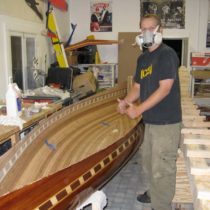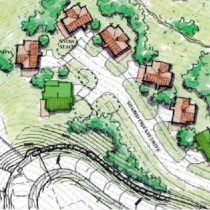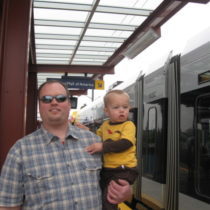Landscape Architecture for Landscape Architects › Forums › GENERAL DISCUSSION › The Suburbs that bad?
- This topic has 1 reply, 11 voices, and was last updated 15 years, 1 month ago by
 nca.
nca.
-
AuthorPosts
-
October 7, 2010 at 7:18 pm #167404
Anonymous
InactiveThe Suburbs are constantly being berated by planners, architects and landscape architects are we being fair? I myself would prefer more dense urban “communities” with a bunch of third places for people to interact in. But the Suburbs did the serve the purpose of providing affordable housing for the post-WW2 gen and the subsequent baby boomer generation. The GI Bill, the US Highway Act, and being able to deduct mortgage payments on taxes did help the develop the suburbs. Teapartiers tend to be more suburbia and have seen themselves living in rural America and not urban America. I agree we need more mass-transit options that connect urban-locii together. But are we landscape architects actively promoting the idea of this time of living? Are we trying to lobby governments to incentivize such living and design? I mean the suburbs are a fairly new way of living. It has always been strictly urban or rural. Early television has I Love Lucy and the Honeymooners set in urban environments. Then in the late 50s and early 60s its all about the ‘burbs’. Are urban settings being portrayed negatively by the media? But wouldn’t an increase in more walkable neighborhoods or dense housing lead to less need for residential landscape architects? How do we facilitate a dialogue to encourage the masses in finding more dense living as preferable to suburbia?
October 7, 2010 at 7:45 pm #167422 ncaParticipant
ncaParticipantI admittedly just skimmed, so sorry if you mentioned this, but I don’t think it’s so much the mid-century suburbs that planners and archs detest so much as the trend over the last twenty years or so.
Alot of the suburban neighborhoods planned post WW2 through to about the 70’s/80’s have gridded/narrower streets, smaller more compact homes and a minimum amount of privacy fncing and culdesacs that seem to plague the 80’s and 90’s hoods. I live in an older suburb and dont mind it. The old growth trees also make a huge difference along with some of the custom architecture from lot to lot.
Thinking ahead, suburbs may seem like the most economically viable option for working class families/vets/ etc but just as someone mentioned in another discussion the ‘true cost’ of living in truly sprawling communities is greater than the initial price tag. Older neighborhoods tend to be built in close proximity to community amenities like corner stores (not a conoco or mobil stationm but a true mom and pop store), grocery stores, hospitals/clinics, etc.
Gotta run, but there’s a start…
October 7, 2010 at 7:47 pm #167421 Ben YahrParticipant
Ben YahrParticipant“Greatest misallocation of resources in the history of the world” -The ever pessimistic James Howard Kunstler
October 7, 2010 at 8:48 pm #167420 BoilerplaterParticipant
BoilerplaterParticipantBut wouldn’t an increase in more walkable neighborhoods or dense housing lead to less need for residential landscape architects?
There would be overall less area of residential lots that need landscaping, so there would be less of that sort of design work, but making walkable neighborhoods includes the creation of streets that are attractive and amenable to walk on. You also need more neighborhood parks, squares, roundabouts, landmarks etc. that lend themselves to creative design opportunities.
A lot of landscape architects have benefitted immensly from the growth of suburbia and so see no reason to lobby for any different kind of built environment. Unfortunately that built environment is one of the reasons for our huge trade deficit and sever economic problems now, and hardly anyone in the higher levels of government want to acknowledge that fact, let alone suggest changes to their constituency. Jimmy Carter tried to get Americans to lower their thermostats and wear sweaters, and was promptly voted out of office. I don’t know how the US is supposed to compete with China and India without changing our living arrangements. All those low-wage Chinese have to live somewhere, and often its in multistory dormitories next to the factory complex, which makes for low housing and commuting costs. Meanwhile factory workers in the US expect to live in auto-oriented suburbia with 2,000-4,000 SF houses. I don’t want to get into discussions of whether they deserve the kinds of wages that allow for that lifestyle, but to make the point that they now have the competition from those in other countries who will work for much less. This trend will influence residential development in the coming years.
October 8, 2010 at 3:26 am #167419 earthworkerParticipant
earthworkerParticipantJust a couple of thoughts….
-What we consider denser urban areas today were actually suburbs at the city limits fifty years ago.
-Many people move to the burbs because the construction of the denser older city areas has become dilapidated and of poor quality construction. I admit, I live in the burbs. Why? Looking at the homes closer to the city,we found the homes were horribly outdated, the neighborhoods were in decline and quite frankly you get more for your money in the burbs. To fix up even a thirty year old house near the city downtown plus the actual cost of what they were asking was completely unaffordable.
-If you want to attract families to city life, you will need some community upgrades. Better dwelling units, better schools, affordable housing, shopping areas and efficient mass transportation would be a good start.…..Oh, and people with jobs who can pay the taxes necessary to make this happen.
October 8, 2010 at 1:42 pm #167418 Noah MabryParticipant
Noah MabryParticipantThe point has already been made, but those original suburbs are today considered urban neighborhoods. And the reason they were built was that conditions in the city were so deplorable that those burbs were intended to escape the unlivable cities. The more we relied on cars and highways the further we were able to live away from the places we work. Oddly enough I have the reverse problem because Columbus made the decision 30 years ago to develop business and office parks around the outer belt so I drive half an hour from downtown where I live to the burbs where I work.
The whole moving of the tax-base to the suburbs left the inner cities to the poor and politically powerless. So, as landplanner said, the schools, housing and transit in the cities do not meet the standards of most families that occupy the outer belt burbs. You can’t just tell people “hey city living is great” and expect them to move without putting the needed investment. It’s gonna take people who really care to make the jump and then push their government officials to make the needed investments.
Tangentially, I just read an article explaining that 30% of people in the US living below the poverty line now live in the suburbs. Additionally in many of the largest metro areas there are actually more poor in the burbs than in the city. Obviously this was spurred by the current economic situation, but should that trend continue it will be interesting to see the political ramifications.
Heres a link to the article: The Recession, Poverty and the Suburbs
So in response to the actual post question. Though not explicitly intentional, the suburbs have been an overall detriment to our cities and society.
October 8, 2010 at 4:10 pm #167417 Jordan LockmanParticipant
Jordan LockmanParticipantAs a person I love my suburb. Living in a good sized metro area the suburbs give you a choice when it comes to where you can live. In my newer suburb there is a focus on walkable communities and parks. I live in a older home but am surrounded by newer neighbors and it is a great place to live.
There is an opportunity for Landscape Architects to take inspiration from the past, but to modernize their designs. We have a “downtown” that is really just a mall, but it is set up so it is walkable and there is a place to park a car or bike or to take a bus. We always use air quotes when we talk about going to “Mainstreet,” but it is a great space to use. The city has gone along with it and created the civic center in the same area. So we can go to the farmers market, walk over to the library, stop and get dinner or some groceries, and it is all walkable.
I look at the suburbs as being a second chance at creating a better city. If I were forced to live in one of the corupt cities that the surburbs surround I might go crazy. Just because it is old and dense does not mean that it is the better place.
The original city was built on a strict grid without care taken to make sure that natural systems were maintained. While my burb is built responding to the natural lakes and wetlands. There is a transit station that will deliver you into the city if you need. My wife has a bike path that goes between our home and her office. So I just don’t see any negative to my suburb.Maybe we all need to be more open minded and accept that if done right the suburbs can be great and we as Landscape Architects are in the position to help create these spaces. So why not embrace the city, suburbs, and rural areas for what they can offer and create sustainable/livable communities in all these places.
October 8, 2010 at 5:17 pm #167416 Andrew Garulay, RLAParticipant
Andrew Garulay, RLAParticipantTransportation enabled suburbia. One could enjoy the benefits of humanity without the burden of it. There seems to ba a philosophy that this must be stopped. While there are and has been an ability to let it just do its thing and become stereotypic strip mall sprawl, that can and is much more under control in communities that want to address it. The idea that we all need to live in urban cores except farmers and loggers is rediculous. The world is full of individual people who each want to live a lifestyle of their choosing.Unfortunately, many choose to live a lifestyle of choosing how everyone else should live. What’s up with that?
October 8, 2010 at 11:10 pm #167415 Geoffrey CampbellParticipant
Geoffrey CampbellParticipantIts a tough issue. The american dream that has been ingrained in much of our population is centered around the suburbian one-acre lot. It doesn’t seem like such a bad thing. Infact, who wouldn’t want to be a landowner with their own plot of land. The problem is that evidence has shown how damaging sprawl can be to the environment. The fact is, suburban living is not sustainable with an ever-increasing population. Yea, nobody should be able to tell anyone how they should live, but when everyone is aware of how damaging the trend is, its gonna get brought up and the alternatives will be proposed. The suburbs can be a nice place to live, but if everyone chooses that lifestyle, sooner or later, our resources and our natural surroundings will suffer because of it…or should I say continue to suffer because of it.
October 9, 2010 at 12:13 am #167414 ncaParticipant
ncaParticipantI don’t think anyone is arguing that we ALL need to live in ‘urban cores,’ but if someone were making that argument, I would probably agree with you. I think, as you’ve stated before, that variety and choice is key.
Transportation enabled suburbia is great if adequate (economical) transportation is available and there still are ‘urban cores’ for people to congregate and work and all that stuff. If we keep building, the same vanilla suburbs, there would hypothetically be nowhere to go, really.
Transuburbs stop making sense in reality when you have a situation such as what we have here on the front range–hundreds of thousands of people going back and forth on the same inadequate, ineffecient, and wasteful highway between the same two places each and everyday.
October 9, 2010 at 1:23 am #167413 Jason T. RadiceParticipant
Jason T. RadiceParticipantI grew up in the ‘Burbs’ w/ a decent sized yard and undeveloped woods behind the house. Then we moved to a larger home IN the woods (but still in the burbs) where we kept as many trees as we could. Honestly, if I didn’t have a yard to play around in, I wouldn’t be a landscape architect. I now live more urban, but cannot wait to buy a house in a more urban-burb. Why? Who the hell wants to live in a crappy condo with neighbors above and below (noisy), no personal yard space. I need test plots for plants. As a musician, I need to be able to make as much noise as I want in my house without the neighbors complaining. There is a VERY good reason why suburbs became popular so long ago, and are becoming increasingly popular in “urban” Europe…people naturally want to live like that. Can it be done better? Of course. And I wholeheartedly agree that the near suburbs to the city core should be redeveloped/gentrified. but that won’t happen until crime is controlled and the schools get much better.
October 9, 2010 at 2:09 am #167412 Suzan MarcionaParticipant
Suzan MarcionaParticipantIt’s actually time for the suburbs to morph, and I think LA’s are the one to come up with the visions. Too many supersize stores that are basically empty with oversize parking lots. I can say that I live in the burbs of NYC. Very accessible, but the planning just doesn’t work, so people end up driving their cars to the village for less than a 1/4 of a mile. Crazy, huh?
October 9, 2010 at 3:41 am #167411 BoilerplaterParticipant
BoilerplaterParticipantYour wife had her own bike path built?
Sorry, I’m a wiseguy. I’m from NJ. I can’t help it.
October 9, 2010 at 3:54 am #167410 Andrew Garulay, RLAParticipant
Andrew Garulay, RLAParticipantYou could look at urban areas as being necessary for the sustainable exploitation of people. No where is the gap between the haves and the have nots more noticible than in urban areas. You have the well to do in their high rise apartments and your poor in their humongous affordable housing complexes or getting their babies shot out of their arms in front of the aging triple decker row house they live in.
You could look at rural living being limited to people exploiting the resources of the land through farming, mining, and logging on one hand and rich people with their private kingdoms on the other.
The thing that so many are brainwashed into ignoring is that suburbia is where the haves and the have nots blend into one community. It is where there is a spectrum between haves and have nots without a gap.
Then there is Portland, OR, the poster child of urban planning. I spent a couple of months in Portland before learning about it in urban planning class a few years later. I found it to be mostly suburbia in a grid within the confines of city limits. It does have a downtown core, but the lifestyle of the vast population within it is suburban. You get twenty blocks from the river and it is ranch houses on postage stamp lots with fences, plants, and lawns. Yup, there is public transportation running up and down those grids from Gresham to Beaverton. And there are convenience stores, fast food joints and 54 strip joints (back in ’91) sprawled all over town , if I can use that expression. Look at google maps and drop the little dude down and look around outside of down town. It is suburbia. If this is the example of the way a city should be, it is a celebration of the better things of suburbia., although I’d take New England suburbia over Portland suburbia any day
Eastern suburbia does not resemble western suburbia. I think it is much more pleasant. The roads are windy, the terrain is varied, and there is no grid outside of a downtown mini-urban core. Its like being rural with houses in the woods and usually particular roads that are strips of strip malls, box stores, and fast food, but the rest of it is very pleasant, very varied, and usually very vegetated. What’s not to like? Some say it is not to like because you typically need a car to get around. That brings up the 800 pound gorilla that no one considers – cost to benefit ratio. Does suburbia demand the car and therefore should be damned, or is the car the damned price that you pay for the benefits of suburbia?
All the philosophic idealism that drives various people comes back to that 800 pound gorilla. Are the things that the new generation has been taught are someday going to destroy the world, although you don’t see it actually happening, so imminent and so disastrous that everyone should ride busses everyday, live in dense housing, and walk down city sidewalks right now?
I’m pretty confident that natural disasters or weapons of mass distruction are going to ruin all of this long before society kills the earth with suburbia and automobiles. It would really suck to give all of it up just to see yellowstone blow what’s left up in an eruption.
My generation cleaned up a lot of stuff left by earlier generations. We are doing better for the following generation, but I’m not ready to live in a cave to hunt and gather in order to leave future generations with perfection. Living on this earth means leaving a footprint. Tread lightly, but don’t forget to walk.
October 11, 2010 at 3:19 pm #167409 Ben YahrParticipant
Ben YahrParticipantEastern suburbia does not resemble western suburbia. I think it is much more pleasant. The roads are windy, the terrain is varied, and there is no grid outside of a downtown mini-urban core. Its like being rural with houses in the woods and usually particular roads that are strips of strip malls, box stores, and fast food, but the rest of it is very pleasant, very varied, and usually very vegetated. What’s not to like? Some say it is not to like because you typically need a car to get around. That brings up the 800 pound gorilla that no one considers – cost to benefit ratio. Does suburbia demand the car and therefore should be damned, or is the car the damned price that you pay for the benefits of suburbia?
Excellent point, suburbs come in various flavors- but so do urban areas. The popular portrayal of cities as dirty and crowded doesn’t apply to all types of effective, higher density living arrangements.
I think the major problem here is that everyone has a preconception of suburbia, and a preconception of urban areas; forgetting that there are pleasant aspects and negative aspects of each.
Despite the fact that many landscape architects discuss the merits of higher density living arrangements and preserving/enhancing urban cores- all incentives support suburbia. Fiscal policies have artificially supported suburbs as cities continue to deteriorate.
No one is forcing a mass exodus from the suburbs on America. Quite the opposite, the American dream thrives, the media portrays the suburbs as safe havens from dingy crime ridden cities. If you feel pressure from your professional peers to support urban initiatives rather than continuing the development patterns of the past, it is not an attack on you or your choice to live in the suburbs- it is a simple analysis of the larger picture.
You describe it perfectly- without a car in suburbia, you are subhuman. That is a huge problem.
Here’s a quick view of my preconceptions for suburbia vs urban living: I live in a neighborhood developed in the 1930s- lots of single family houses, some 3-4 story apartment buildings, small yards, houses close together, friendly neighbors, beautiful trees, single car or nonexistent garages. Within comfortable walking distance (1/2- 3/4 of a mile) there is a library, bank, two pharmacy’s, veterinarian, dentist, barbershop, schools, 5 parks, bike paths, two grocery stores, three coffee shops, eight restaurants, two bars, and numerous stores. Only the grocery store is a national brand- the remaining businesses are local, with a few regional brands. Many people go through an entire weekend without using their cars.
My office is in the suburbs. Winding roads that make it impossible to find your way around, street trees are a scrawny afterthought, the roads are extremely wide to accommodate the nonexistent demand for street parking, businesses have huge parking lots that are rarely ever even half full, there are a ton of cheaply constructed apartment buildings, townhouses, and condos (density), and the prominent design feature of the houses (besides privacy fences) is the garage. Within walking distance there is nothing– because sidewalks are far from continuous, and there is a four lane arterial road separating the “business” areas from the “commercial” areas from the “residential” areas. People literally drive their cars 1/2 mile to get to restaurants that are 500 feet away from our office at lunch, because walking is not safe. If walking were possible, within 3/4 mile, there would be a grocery store, a pharmacy, a coffee shop, a bar, and around ten restaurants. With the exception of two restaurants, all are national or regional brands.
These philosophical discussions of the merits of suburban sprawl or denser redevelopment of cities are healthy, and there are still plenty of options available for each to choose their favorite flavor.
-
AuthorPosts
- You must be logged in to reply to this topic.


